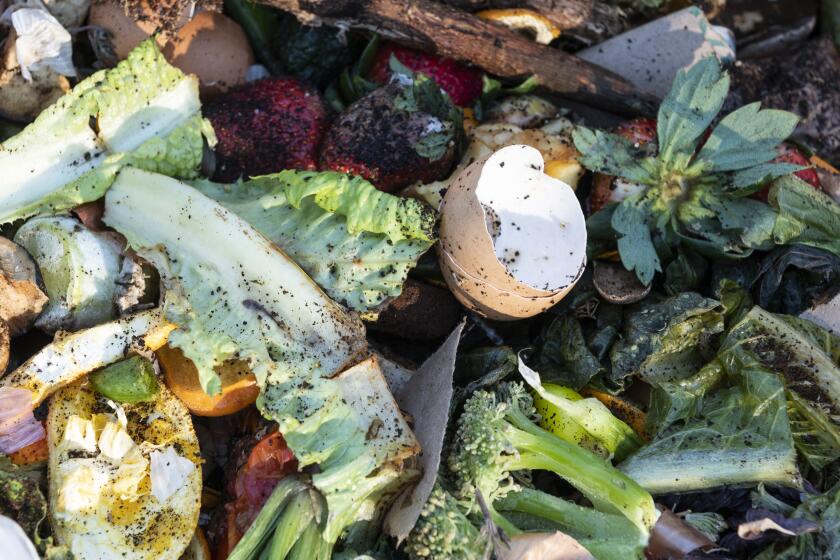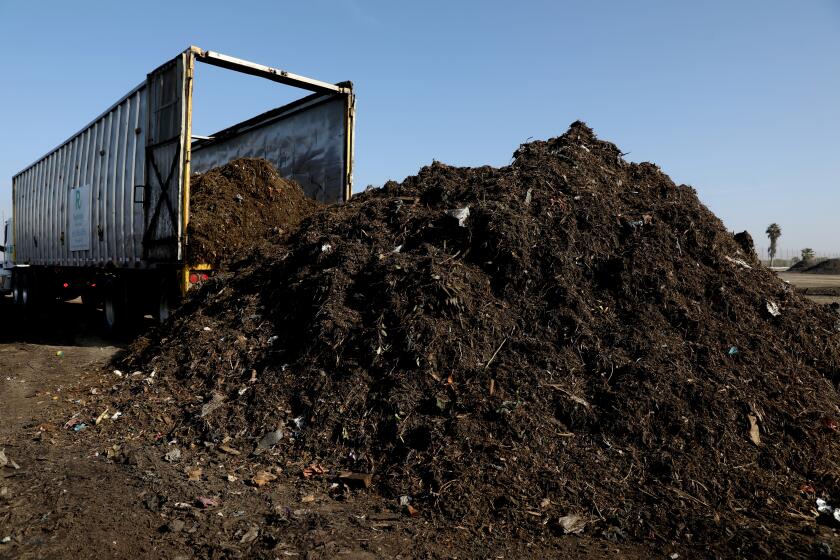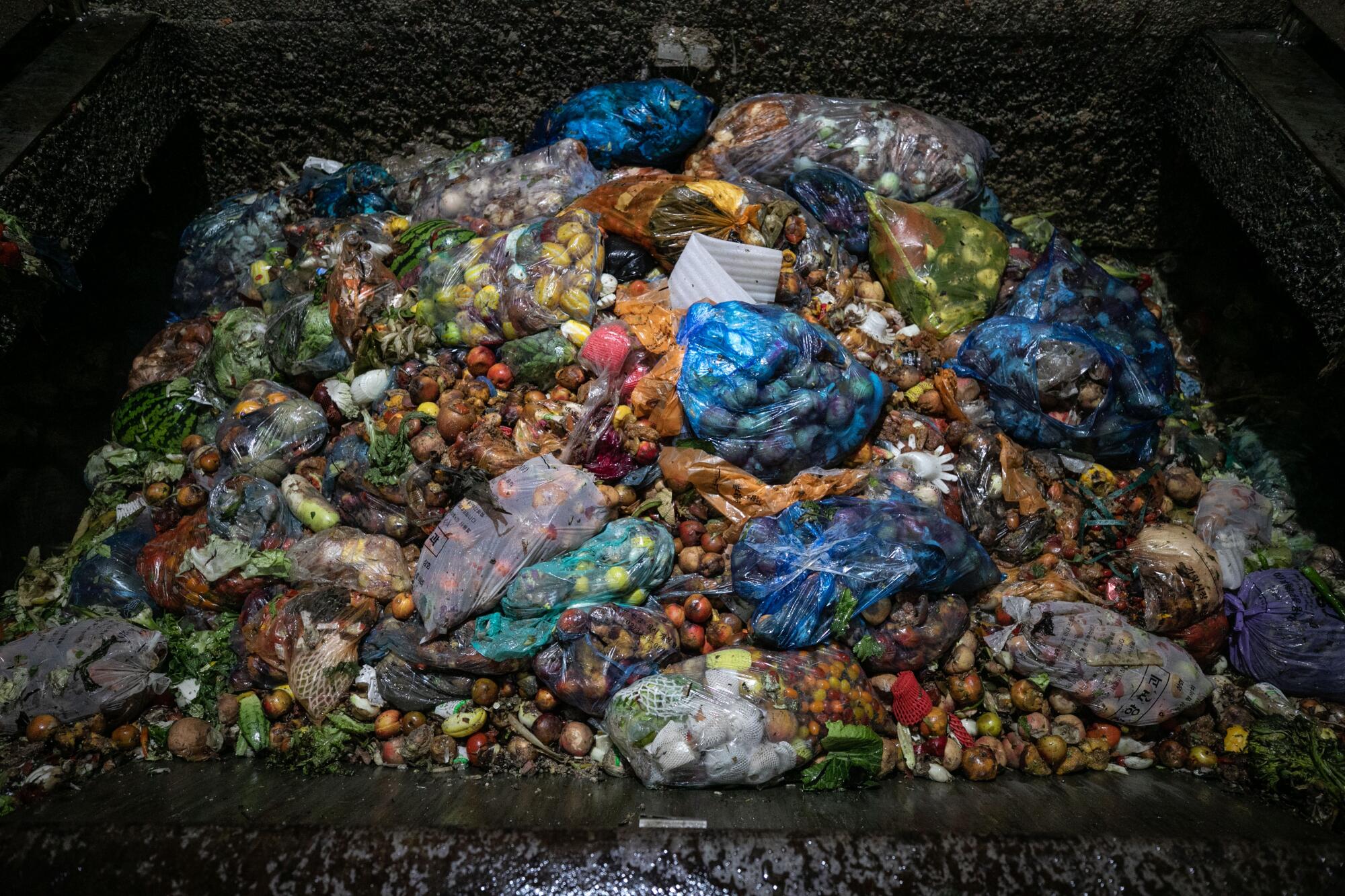
- Share via
SEOUL — Striding through a field of overgrown grass where thick blue pipes crisscross into concrete silos, Choi Sung-ho scrunched his nose in the steamy July heat, drawing in a familiar odor.
Located just off a highway that leads out of Seoul’s western border, Nanji Sewage Treatment Center, where Choi works, primarily deals with the human waste produced in Seoul’s toilets. But the smell now wafting up is that of decomposing food.
That smell is a constant source of tension between the center and nearby residents, who have called to complain so many times that the head of the facility no longer lists his personal phone number on his business card.
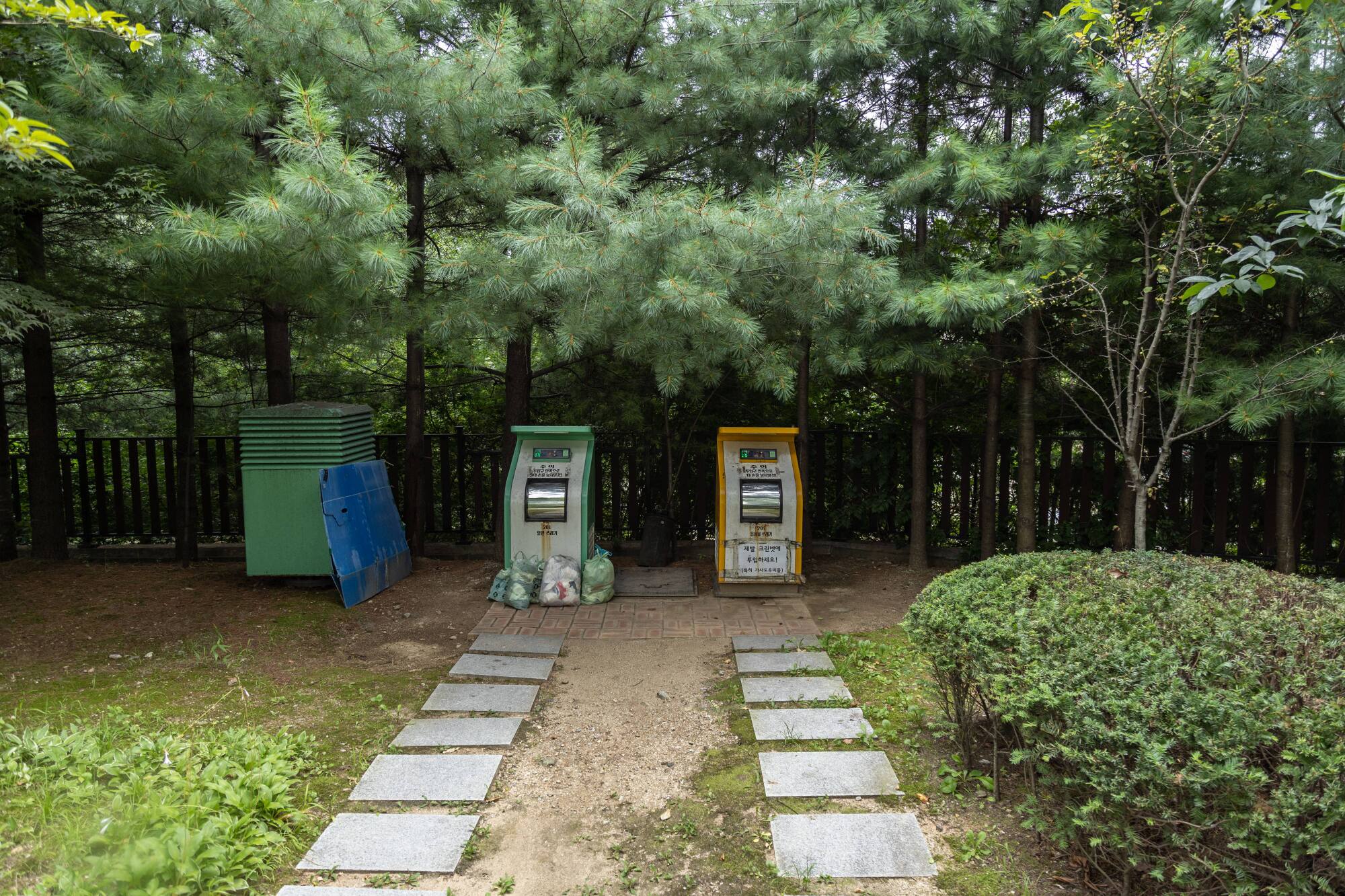
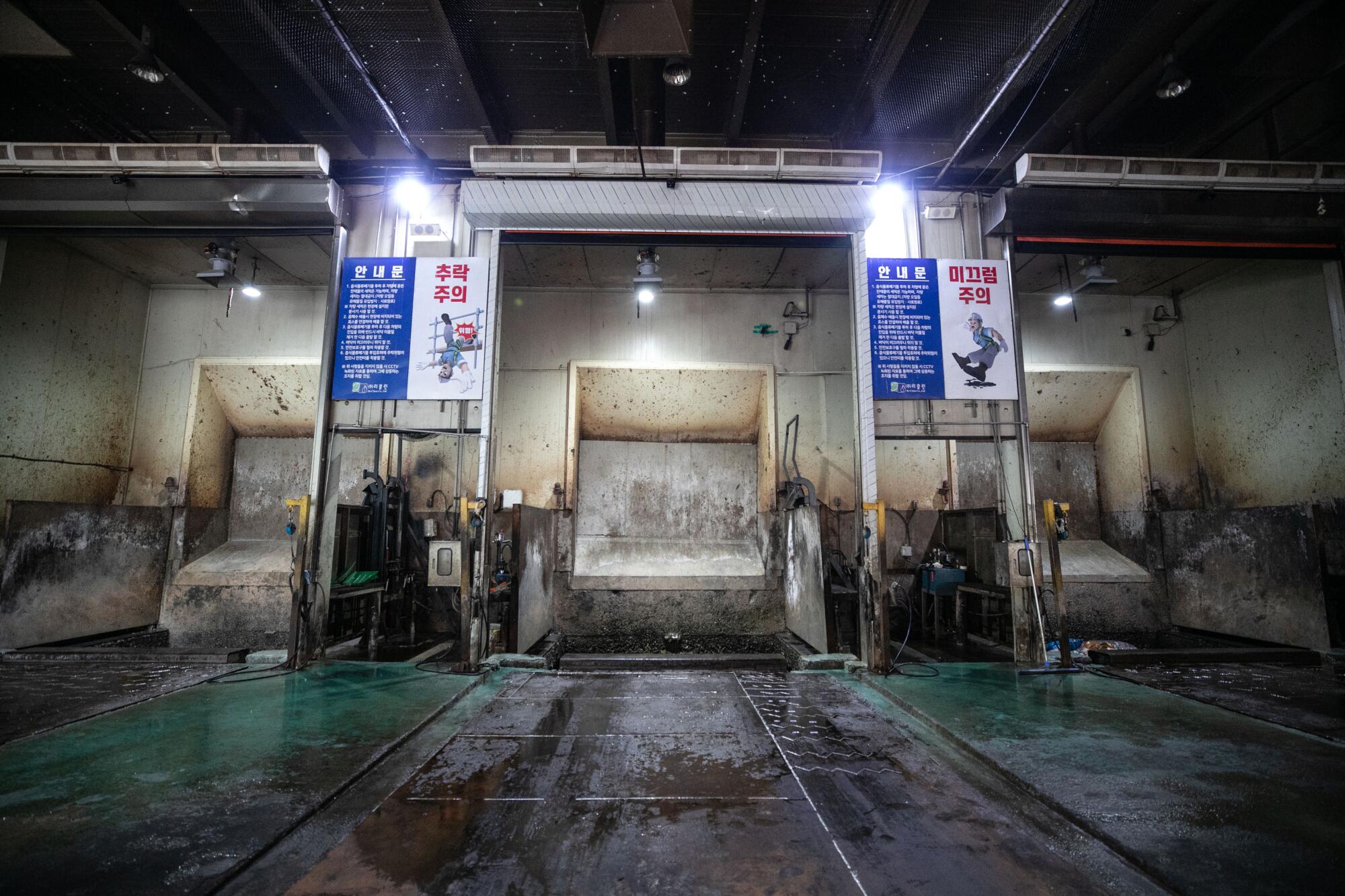
Choi is sympathetic to these concerns. Fielding such complaints is as much a part of this job as keeping the sludge flowing smoothly. But in a city of 10 million that produces 2,500 tons of food waste daily, the plant’s role in recycling it is as essential as it is thankless.
Since South Korea banned land-filling food waste in 2005, followed by another ban on dumping its liquid byproduct (known as leachate) into the ocean in 2013, the country has operated a comprehensive composting program that recycles almost all of its discarded food into fertilizer, animal feed or, in the case of Nanji Sewage Treatment Center, a type of fuel called biogas.
Schedule a time to pick up your free compost pail from the city — that’s because it’s also time to stop putting food scraps in the trash, as California law requires.
Every day, the plant processes about 130 or so tons of leachate from waste-collection companies in the surrounding area. The liquid is poured into the concrete tanks, where, over a period of 15 to 30 days, it will be broken down by microorganisms in a process called anaerobic digestion. The biogas that this process yields is then captured and sold to a local utility, which will use it to heat the area’s homes.
“It’s just like digestion in people,” Choi explained, tapping his stomach. “We maintain the tanks at 36 or 37 degrees Celsius, similar to the temperature in human bodies.”

The food waste that ends up at Nanji Sewage Treatment Center starts out in a translucent yellow bag, which South Koreans have been required to use for throwing out their uneaten food since 2013.
By purchasing them, which are priced at around 70 cents per liter and sold at any convenience or grocery store, residents effectively pay a tax on the food that they are throwing away. The revenue from the bags is collected by each district and used to offset a portion of the costs of transporting and processing its food waste.
“In Seoul as a whole, bag fees pay for about 40% of the total cost of processing, which costs the city about $153 million annually,” said Jang Ji-ae, head of the municipal food waste management team.
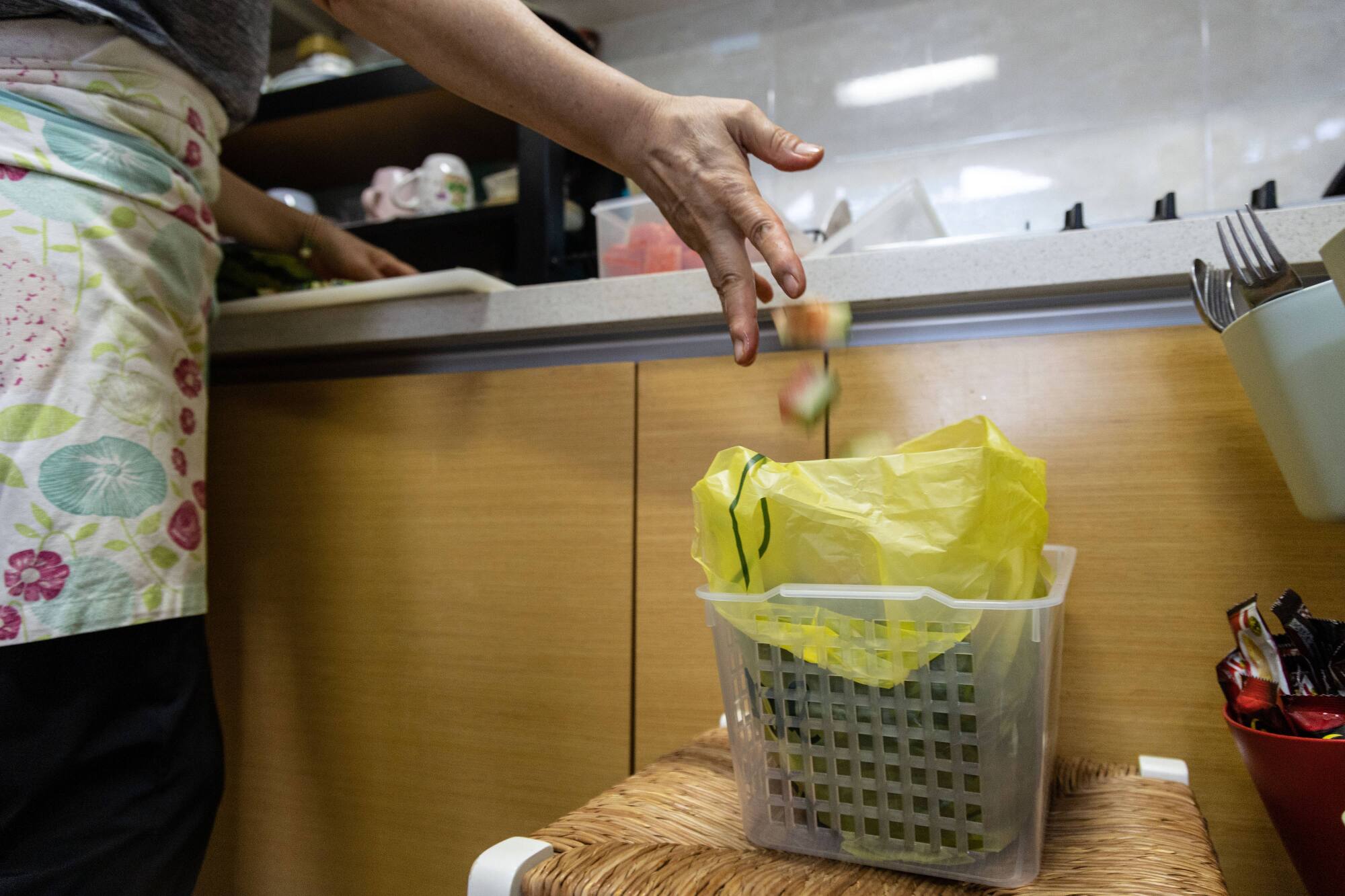
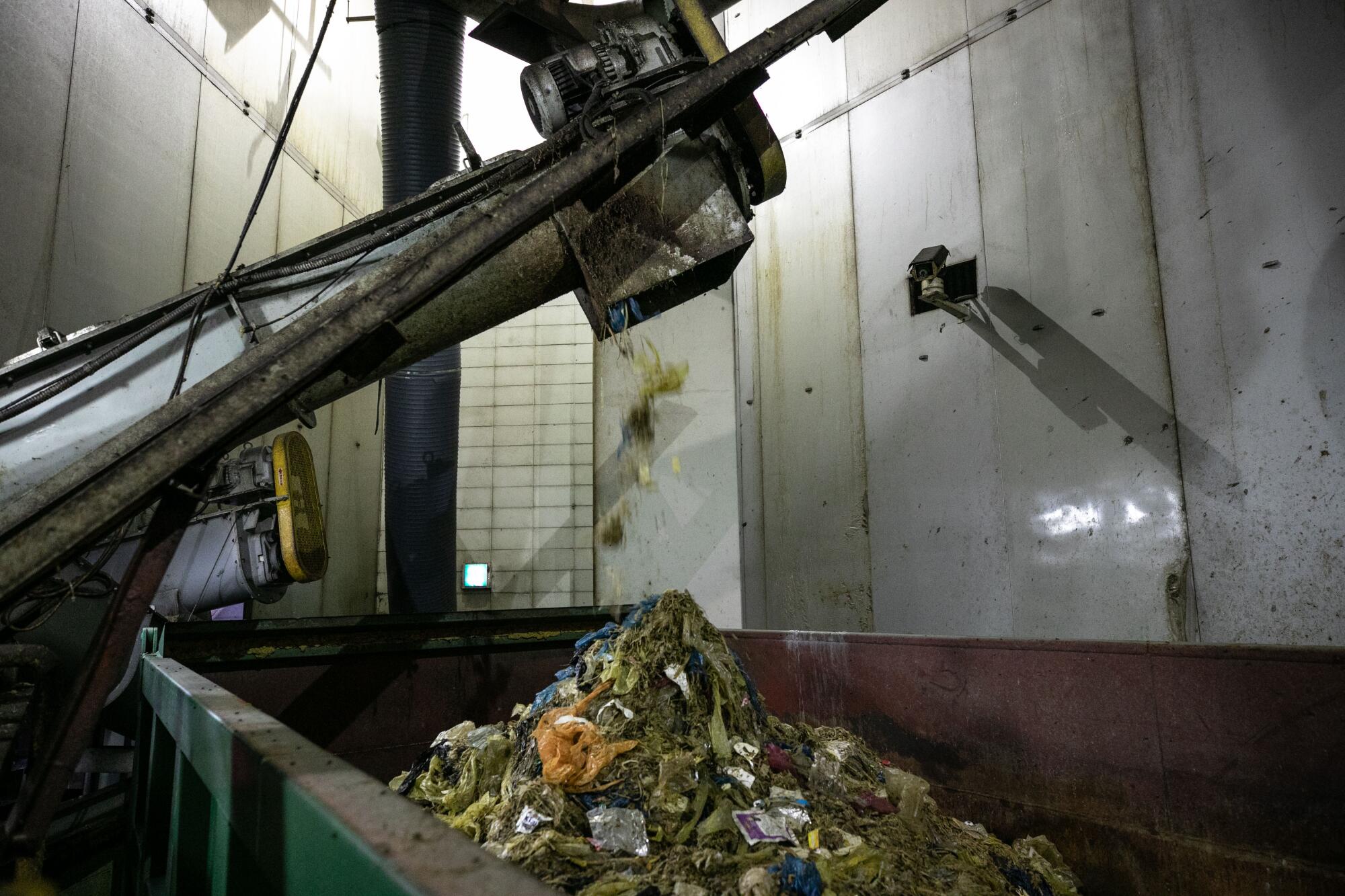
The routine is second nature to every Seoul resident: squeeze out any moisture and place the full bag in a personal green bin by the curb after sunset. In some apartment complexes, residents can skip the bags and put their food waste in electronic waste bins that will automatically weigh their contribution and charge them accordingly.
These methods encourage people to come to grips with the waste they create. “You are able to perceive just how much you are throwing away,” Jang said. “That makes people uncomfortable.”
Landlords are responsible for providing renters with a green bin to comply with California’s composting law.
Later, at processing facilities around the city, the bags will be stripped off and any foreign objects removed from the sludge. The remaining contents will be squeezed, dehydrated and processed into fertilizer or animal feed, while the liquid runoff is sent to wastewater plants like Nanji.
Under this scheme, the country currently recycles close to 100% of its food waste, a remarkable jump from just 2.6% in 1996.

This effectiveness of the South Korean system has made it a model case study for government officials in other countries, many of whom reach out to their counterparts in Seoul for advice.
Last year, Jang’s team held a Zoom consultation session with officials in Tokyo. In Japan, food is thrown out along with general waste and later incinerated, but the Tokyo officials were exploring the possibility of a recycling-oriented alternative.

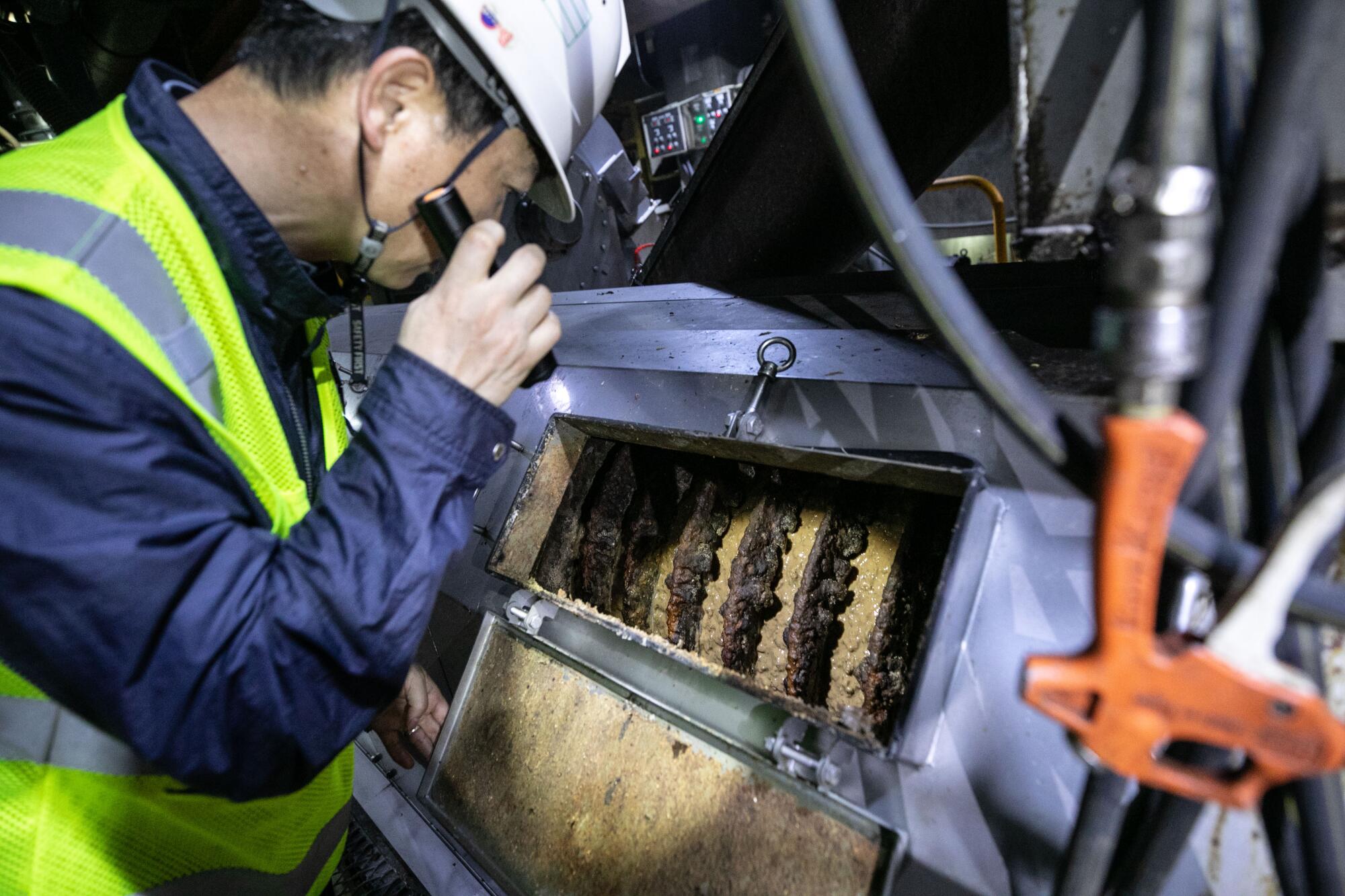
“They were most curious about how to separate food from general waste,” Jang said. “They really wanted to know whether people would actually be willing to go along with something like that.’”
In South Korea, the separation of food from general waste — the bedrock of any recycling system — began in the late 1990s.
Editorial: Don’t stop composting. California can’t afford to abandon its methane-busting law now
The state’s independent good government commission says California won’t make its 2025 organics recycling goal and the Legislature should suspend the law. But that would set back an important program to fight climate change.
An intense period of urbanization had led to overcrowding in the capital, while rising standards of living were leading to levels of waste unseen in more frugal times. Residential areas pushed up against massive landfills that had reached their limits, leading to frustration toward the odors and pests.
According to Jang, these direct sensory encounters with the unpleasant consequences of food waste gave the issue an explosive political charge in the country. That paved the way for the banning of land-filling food waste in 2005, but most important, it primed people for accepting the added inconvenience of disposing of their food waste separately.
Still, the first few years followed a learning curve.
If the Golden State is going to lead the world toward a better, safer future, our political and business leaders — and the rest of us — will have to work harder to rewrite the California narrative. Here’s how we can push the state forward.
“There was a lot of trial and error, lots of experimentation,” said Kim Mi-hwa, chairwoman of the Korea Zero Waste Movement Network, a national coalition of 180 environmental groups that worked with the government on the recycling scheme. “I would say it was only in 2013 or so that we could call it a success.”
One early problem was the rule-breakers. Unaccustomed to having to separate and collect food waste indoors, where careless storage would lead to an odor problem, many resorted to sneaking their food waste out to public waste bins. Local governments offered rewards to tipsters who reported offenders, who in turn would be fined.
“At subway stations back then, you’d see signs telling people not to throw their food waste away there,” Kim said. “That was a common one — people would throw out their food waste in the bathroom on the way to work.”
But punitive measures had their limits, and it was ultimately grassroots activism by Kim’s group that helped things fall into place. Across the country, local organizations canvassed neighborhoods and persuaded people to take part. “We would hold public forums or go through trash bags with residents to explain why mixing waste was a problem,” Kim said. “We did over 1,000 such outreach events each year.”

The recycling scheme itself also had its fair share of speed bumps. The current method of processing food waste into fertilizer, animal feed and biogas followed several failed experiments such as feeding raw food waste to ducks or composting it on large-scale earthworm farms, neither of which could handle waste at scale.
Today, mainly due to concerns about diseases such as African swine fever, animal feed is also on its way out. Under a new national law aiming to reduce the use of carbon-intensive fuel sources, Seoul will have to expand its production of biogas — which currently represents 7% of its total food waste recycling output — to 50% by 2026. To meet this goal, a new biogas production facility is being developed for Nanji.

Globally, too, recycling food waste is increasingly becoming a top priority in the response to the climate crisis.
In California, landfilled food waste accounts for 20% of the state’s methane emissions, which has led to the passage of Senate Bill 1383, a statewide organics recycling law that went into effect in 2022 and requires residents to separate their food from general waste.
And in step with a larger push in the United States to increase its own anaerobic digestion capacity, California has recently been ramping up its own food-to-biogas program.
More important than explaining the rules of curbside composting is getting L.A. residents on board in the first place.
Though aware of the global interest in South Korea’s success story, Kim is unsure what, if any, applicable lessons the country’s model really holds. The best recycling scheme is one that is suited to the unique circumstances of the country in question, and the most fundamental puzzle — persuading an entire citizenry to voluntarily separate their waste — is far from an exact science.

“I think what the South Korean model proves is that it can be done if you put in the time and effort into education and outreach,” Kim said. “South Koreans didn’t suddenly become conscientious overnight. But minds can be changed over time.”
This belief will be put to the test again in the near future, as the country picks up its efforts to reduce food waste at the source. “South Korea is a huge importer of food,” Kim said. “There is an ethical problem in transporting so much food here, only to throw it away.”
In doing so, South Koreans will be called upon to accept still more radical changes.
To further dis-incentivize waste, Seoul is considering whether to increase food waste disposal fees, a measure that will probably prove to be contentious.
Kim, on the other hand, believes that the long-standing tradition of restaurants offering free refills of banchan — side dishes that accompany Korean meals — needs to end. “Customers should have to pay for side dishes à la carte, so they only order what they will finish,” she said.
This is wading into controversial territory. Free refills on banchan are increasingly being highlighted as a significant cause of waste at restaurants, but they are also a sacrosanct part of Korean dining.
It will be Kim’s hardest sell of all.
More to Read
Sign up for Essential California
The most important California stories and recommendations in your inbox every morning.
You may occasionally receive promotional content from the Los Angeles Times.

